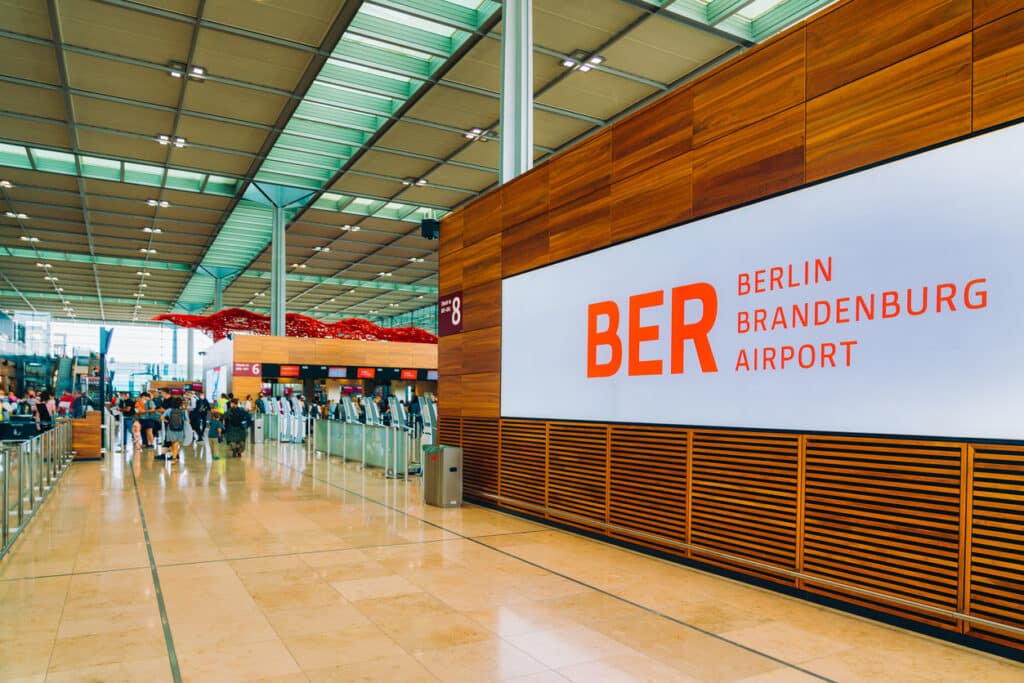Of the commercial airports over two dozen can be considered “international airports”. These international airports range in size from the mega complexes in Frankfurt and Munich servicing tens of millions of passengers a year to smaller airports in medium size cities that may fly anywhere from 220 thousand passengers (Zweibrücken Airport) to over 5.2 million passengers (Hannover Langenhagen Airport). The large airports can have up to 125 different airlines serving hundreds of destinations with hundreds or of takeoffs and landings each day.
Many of the medium sized airports offer flights by mainstream airlines such as Lufthansa as well as trips on low-cost and charter airlines such as RyanAir, German Wings, Air Berlin TUI and Condor. They also often offer substantial numbers of flights to cities throughout Germany and Europe. In the smaller airports much of the traffic is with low-cost airlines and charter companies. The charter carriers most often serve vacation destinations in warm climates.
The former U.S. air base at Hahn, 75 miles from Frankfurt, was one of the first to offer flights from low-cost airlines and also served as a model for the conversion of former military air bases to commercial airports.
There is also a very successful program to link air travel to rail travel at certain large hub cities. High-speed InterCity trains directly serve the Frankfurt, Düsseldorf, Cologne-Bonn and Stuttgart airports.

Frankfurt Airport
Frankfurt is the busiest airport in Germany (www.airportcity-frankfurt.com) and welcomed more than 58 million passengers in 2013. Frankfurt has scheduled connections to nearly 300 airports in more than a hundred countries. A global Top 15 airport, Frankfurt ranks as the 12th busiest for total passengers (seventh for international passengers) and eighth for total cargo tonnage (seventh for international freight). The airport ranks fourth in Europe (after London-Heathrow, Paris and Amsterdam) for passengers and second in terms of cargo (after Paris). There is an average of 1,295 flight takeoffs and landings at Frankfurt Airport each day.
Many of the passengers had Frankfurt itself as a destination, since the city is an important commercial center. But Frankfurt is also a transfer point for air and rail connections to other German cities and an air transfer point to many other countries, notably in Eastern Europe and Asia.
Europe’s busiest expressway cloverleaf, the “Frankfurter Kreuz” is right adjacent to the airport. This is where the A3 and the A5 autobahns, the most important in Germany, intersect and allow quick access to Europe’s extensive superhighway net. In addition the airport has its own bus station and a large number of parking spaces, including long-term ones, and ones for the disabled, women only and large vehicles.
But stress is being laid on reaching the airport swiftly and comfortably by rail. More than 170 long distance trains a day stop at its railway station, affording passengers direct connections to Cologne, Hamburg, Munich, Berlin, Dresden, Nürnberg, Stuttgart and many other German cities, not to mention Vienna, Milan, Zürich and Amsterdam. Some airlines even have check-in counters right at the station.
The high-speed Frankfurt-Cologne rail line, which cuts travel time from two-and-a-half hours to less than an hour, also serves both the Frankfurt and Cologne-Bonn airports. Frankfurt long has had a second railway station, offering rapid transit service to the Rhein-Main area, and this continues to operate.
Munich Airport
For all that, Frankfurt is getting stiff competition from the Franz Josef Strauss Airport in Munich (www.munich-airport.com), which is Germany’s second air hub.
In 2014, Munich Airport has been named “Europe’s Best Airport” in the World Airport Awards by Skytrax, a London-based aviation consultancy. At the global level, Munich was named the third best airport in the world. The Bavarian hub improved its position from the previous year and was placed among the world’s best airports the 10th time in a row. Furthermore the airport gained top ratings for airport dining. According to the passengers, Munich has the world’s second best airport restaurants and offers more than 45 choices for dining. Additionally, the Kempinski Hotel at Munich Airport was chosen as Europe’s second best airport hotel.
The number of passengers reached 38.7 million in 2013. The airport’s growth is largely due to Lufthansa’s decision to implement a major expansion program at Munich Airport and led first to an expansion of the original Munich terminal and then to the opening of a second terminal. Munich Airport offers an outstanding range of destinations and is Europe’s top air transportation hubs based on the total number of offered destinations. With its extensive schedule of flights to and from Italian cities, Munich Airport has earned the nickname “Italy’s most northerly airport.” In summer, almost up to 400 weekly flights are serving Italian destinations. Connections to central and eastern Europe are also excellent.
Situated in the heart of Bavaria, Munich Airport is within easy reach of the Alps. If you are heading for Austria, Switzerland, Italy, the Czech Republic or Slovakia, Munich Airport is a short trip by car or train to these destinations.
Düsselfdorf Airport
The third busiest airport in Germany is Düsseldorf (www.duesseldorf-international.de), which counted 21.2 million passengers in 2013. It too has a relatively new terminal, replacing and greatly improving upon the one that was destroyed by a disastrous fire in 1996. And Düsseldorf, like Frankfurt, has two railway stations, one for long distance and InterCity trains and one for the local area. A “Skytrain” connects the long distance station to the terminals.
Berlin
During the Cold War there were four airports servicing Berlin – one for each of the occupying powers. The Americans operated Templehof; the French operated Tegel; the British military airport was at Gatow and the Russians operated Schönefeld. After German reunification Berlin traffic was divided between three airports: Tempelhof; Tegel, and Schönefeld. Templehof was closed in 2008 leaving Tegel and Schönefeld as the two facilities handling commercial traffic to Berlin.
Now, the future of Berlin aviation lies mainly in the planned Flughafen Berlin-Brandenburg International (BBI). However, there is no specific date set for the opening of the new airport, which is being built adjacent to the Berlin-Schöndorf location. Construction of the new facility started in 2006. However there have been a series of ongoing problems regarding planning, construction management and corruption that have continuously delayed project. Originally scheduled for operation in 2010, it is now scheduled to maybe open up in 2015 or even 2016 or later. It is planned to close Tegel when BBI opens.
Cologne/Bonn
The Konrad Adenauer Airport, between Cologne and Bonn, is one of the home bases for Germanwings and other low cost airlines. And its railway station connects it to the Frankfurt Airport in less than an hour on the high speed InterCity line. This opens up many possibilities for connections that should contribute to the airport’s growth and also relieve the Frankfurt runways to some extent.
Frankfurt-Hahn
The “cheapy” center at Hahn racked up 2,667,529 passengers in 2013. The Irish no-frills airline Ryanair has made the so-called “Frankfurt-Hahn” airport its hub, and will fly you from there to Stansted Airport, near London, for as little as €20.
Ryanair offers similar bargain service to more than 50 other European destinations The catch is that, despite that name “Frankfurt-Hahn,” the airport actually is 125 km (75 miles) from Frankfurt, and it takes about an hour and 30 minutes to get there.
Hamburg
The Fuhlsbüttel Airport in Hamburg also is also becoming very modern. In 2005 it got a state-of-the art terminal, and also has an urban railway (S-Bahn) link-up, a shopping plaza and a hotel.
Stuttgart
The Stuttgart Airport is just off Autobahn 8 to the south of city of Stuttgart. It is a major hub with over 9.5 million passenger a year making it the 6th busiest airport in Germany. It is easily accessible by autobahn, high-speed rail and S-Bahn from the city. The Stuttgart Trade Fair Exhibition Center opened next to the airport in 2007. Construction in 2004 replaced the aging terminal with four new passenger terminals. They offer all of the amenities of a very modern airport.
You can click here for a list of airports in Germany that includes links to each.
In the wake of September 11, Germany established flight safety rules similar to the ones in effect in the U.S., including the ban on knives, scissors and the like in hand baggage. Security at Frankfurt and Munich is especially tight on transatlantic flights, on flights to Israel and on flights by British and American airlines no matter where they are headed. It’s important that passengers, especially ones on these flights, get to the airport well before takeoff. Some officials urge as much as three hours for international flights.
Many German airports feature duty-free shops, restaurants, bars, car rental agencies, conference centers, banks, post offices and medical facilities. And sometimes they offer much more. Many have hotels on the premises right next to them.
Article updated August 18, 2014


























